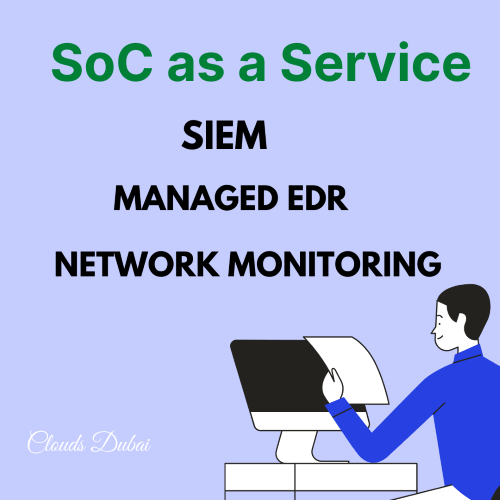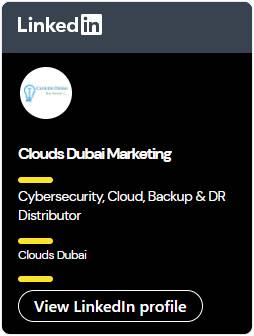SOC as a Service or Security Operation Centre as a Service is a Managed Security service offering 24/7 support to monitor, identify, and remediate cybersecurity threats of an organization. SOC as a Service gives the flexibility to customers to have an advanced cybersecurity monitoring solution without investing in expensive SIEM, SOAR, Threat Intelligence, IDS, or vulnerability Assessment tools. SOC as a Service provides managed threat identification and response round-the-clock to improve the security posture of an organization continuously. With the ever-increasing risk of cyber threats, the sophistication of the tools we use to identify those threats and risks along with the expertise of the security experts helps you to stay secure.
The service is provided by the Global Security Operations Center based out of UAE and India.
What is SOC as a Service?
SOC as a Service is a managed security offering with 24/7 Monitoring, Incident Response, and forensics that can handle all your Cyber Security needs. Your entire network and cloud instances with data centers, servers, networking devices, workstations & applications will be monitored for security incidents and indicators of compromise (IOCs). Our SOC service offering is very cost-effective for organizations of all sizes and the SOC as a Service pricing works on a SaaS model (pay-as-you-go model). SOC services pricing depends on the number of assets or IPs that need to be monitored under the service.
The following areas will be covered by Managed SOC
We offer SOC as a Service by providing comprehensive Risk Management with integrated SIEM (Security Information and Event Management), SOAR (Security Orchestration), Network Traffic Analysis, Sandboxing, and Intrusion Detection to detect and remediate potential threats. The solution includes integrated asset discovery and inventory management via passive & active scanning for the assessment of asset criticality.
The Op-ex model of SOC as Service makes sure that the customers only pay for the service they use and do not need to invest in additional hardware or software.
Cost-effective SOC as a Service offering
SIEM component of SOC as a Service solution takes care of log management & correlation. It also includes integrated asset discovery & inventory with the help of passive & active scanning tools and allows for the assignment of asset criticality. As part of the onboarding process, we will conduct vulnerability scanning, reporting, and management of those vulnerability stats, to assist customers in addressing the most critical items.
This is performed by both internal (authenticated) from SIEM, and external (unauthenticated) from the security operations center (SOC). This information is integrated with SIEM feeds to refine threat detection and analysis and reduce false positives by our security analysts. Security-relevant logs are sent to the SIEM solution that can be deployed as an on-premise, cloud, or hybrid model.
The Network Monitoring component of managed SOC as a Service solution provides web-based network traffic analysis and network flow collection. Implementing effective application monitoring that allows your organization to quickly detect application, service, or process problems, and take action to eliminate downtime for your application users. We use tools for monitoring the latest threats in applications and application state – including Windows applications, Linux applications, UNIX applications, and Web applications.
As a Managed Security Services Provider, we deliver proactive managed cybersecurity solutions with SOC as a Service offering. This offers much more than Software as a Service and goes well beyond mere “alerting”. It involves taking relevant steps to identify indicators of compromise so that necessary actions can be taken to prevent attacks.
We deliver to customers:-
● Award-winning technology with 24 x 7 x 365 monitoring, event analysis, and remediation advice by security experts
● Security Orchestration to automate tasks to reduce the turn-around time by SOC analysts
● Client-specific tuning, correlation rules, and event escalation by our SOC team
● Assistance with root-cause analysis of events and real-time alarms
● Interactive remediation-knowledge-sharing
SOC service helps customers comply with IT Security standards by providing multiple essential security capabilities in a single solution. SOC as a Service pricing depends on the number of overall IT assets covered and the components selected as part of the SOC service. In one unified solution, it offers:-
- Asset Discovery: Know who and what is connected to your network at all times.
- Vulnerability Assessment: Know where vulnerabilities exist to avoid exploitation and compromise.
- Intrusion Detection: Continuously monitor your networks, hosts, and Infrastructure environments to detect anomalies and attacks like malware, ransomware, and brute force authentication.
- Security Orchestration: The security Orchestration and Response module enables adaptive response to malicious security events. It increases the speed and efficiency so that repetitive and common steps performed as part of the analysis are automated through workflows to react and respond to cyber incidents rapidly.
- Integrated Threat Intelligence: Receive continuously updated threat intelligence from the Security Research Team and the Open Threat Exchange, including correlation directives, vulnerability signatures, indicators of compromise, guided threat responses, and more.
- Network Traffic Analysis: Enable passive network monitoring that focuses on flows and statistics that can be obtained from the captured network traffic.
- Suspicious Activity Monitoring:- Monitors endpoints in real-time for any suspicious activity with a combination of behavioral analysis and machine learning in SOC as a Service to identify any Indicators of Compromise (IOC) and advanced threats.
- User Behavior Analytics: Effectively monitors out-of-norm events and incidents to identify insider threats, compromised accounts, abnormal user behavior, changes/accesses to privileged files/folders, etc.
- Ransomware Detection & Response: Stop Ransomware in Its tracks with advanced threat detection. Real-time threat detection with built-in essential security capabilities & coordinated incident response with integrated analysis and reporting help stop Ransomware.
SOC as a Service Pricing
SOC services pricing is calculated based on the total number of assets covered and the components (SIEM, SOAR, NIDS, etc.) subscribed by the customer. The number of external applications is also considered for arriving at managed SOC pricing.
Request a quote for SOC as a Service
Managed SOC Workflow
Security incident response has become an important component of information technology programs. Cybersecurity-related attacks have become not only more numerous and diverse but also more damaging and disruptive. New types of security-related incidents emerge frequently. Preventive activities based on the results of risk assessments can lower the number of incidents, but not all incidents can be prevented. An incident response capability is therefore necessary for rapidly detecting incidents, minimizing loss and destruction, mitigating the weaknesses that were exploited, and restoring IT services. Details of the SOC-as-a-service workflow are given below.
Plan
> The first phase deals with Incident preparation.
> Each organization needs a plan that meets its unique requirements, which relates to the organization’s mission, size, structure, and functions. The plan should lay out the necessary resources and management support.
> The incident response plan will include the Mission, Strategies and goals, organizational approach to incident response, metrics for ensuring incident response capabilities, and a roadmap for maturing the incident response process.
> Proper coordination and communication mechanisms will be decided upon in this phase including contact information of necessary people, issues tracking system, a secure storage facility for storage of evidence, etc.
Detect
> This phase builds upon the information from the planning stage along with various security solutions to perform incident detection and analysis.
> The incident response team will work quickly to analyze and validate each incident, following a pre-defined process and documenting each step taken.
> If a suspected incident has occurred, the team will rapidly perform an initial analysis to determine the incident’s scope, such as which networks, systems, or applications are affected; who or what originated the incident; and how the incident is occurring.
> After initial analysis the incident is prioritized based on the functional impact, incident recoverability, and information impact then the appropriate individuals /teams are notified.
Respond
> The detect phase assigns priorities to incidents and depending upon this, appropriate responses are carried out.
> Containment is carried out before the incident overwhelms resources or increases damage.
> Incident data is gathered for future reference and also to resolve the incident, this data may also be used for legal proceedings.
> After an incident has been contained, eradication may be necessary to eliminate components of the incident, such as deleting malware and disabling breached user accounts, as well as identifying and mitigating all vulnerabilities that were exploited.
> During eradication, all affected hosts within the organization are identified so that they can be remediated. For some incidents, eradication is either not necessary or is performed during recovery.
> Incident data is collected and stored in the Knowledge Base.
Post Incident Activity
> This phase deals with round-the-clock monitoring and protection. It makes use of all data defined in the various stages.
> Working hand in hand with respective device management teams to ensure continued protection.
> Ensure that various controls are in place to protect the system including host security, network security, malware protection, etc.
> It is a continuous process.
SOC as a Service Component
SIEM & SOAR
SIEM & SOAR are the main components of SOC as a Service. SIEM component includes integrated asset discovery, log & inventory management. SOAR automates the majority of actions that SOC Analysts take, thus increasing efficiency and reducing the number of alerts. The Threat Detection and Alerting abilities of SIEM solution provide:-
● Automated real-time ”unified” log correlation
● Integration of all available security data
● Application of correlation rules to assets, vulnerability, network traffic, and threat data
● Integrated proprietary and crowd-sourced threat intelligence
● Ability to deploy additional integrated security controls
● File Integrity and privileged-user monitoring
● 24 x 7 x 365 alerting with “full threat context”
● Linkage to all log data related to the threat
● Evaluation and elimination of systemic “false positives”
Network Intrusion Detection
Network Intrusion Detection is another key SOC as a Service component that provides web-based network traffic analysis and network flow collection.
Key Features include:
> A fully managed network and host-based IDS technology with leading industry threat feeds and rule-sets
> Sort network traffic according to criteria related to IP address, port, protocol, throughput, Autonomous Systems
> Show real-time network traffic and active hosts
> Produce long-term reports for several network metrics including throughput and application protocols
> Monitor and report live throughput, network and application latencies, Round Trip Time (RTT), TCP statistics
> Store disk persistent traffic statistics to allow future explorations and post-mortem analyses
> Geolocate and overlay hosts in a geographical map
> Alerts engine to capture anomalous and suspicious hosts
> SNMP v1/v2c support and continuous monitoring of SNMP devices


